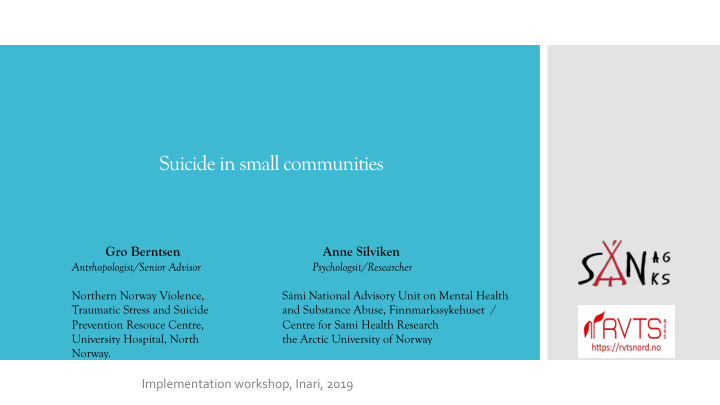



Suicide in small communities Gro Berntsen Anne Silviken Antrhopologist/Senior Advisor Psychologsit/Researcher Northern Norway Violence, Sámi National Advisory Unit on Mental Health Traumatic Stress and Suicide and Substance Abuse, Finnmarkssykehuset / Prevention Resouce Centre, Centre for Sami Health Research University Hospital, North the Arctic University of Norway Norway. Implementation workshop,1Inari,12019
“A(person´s(death(is(not(only(an(ending: Quoteby(Shneidman,(1973 it(is(also(a(beginning(– for(the(survivors”
! «Everybody»'knows each other Suddenand'unexpecteddeath ! Traditional close ties'and'multiplex relations in'Sami'communities in'smallcommunites ! Contagion of suicide
! Sudden&and&unexpected&death&represents&a&severe&life&event& incorporating&multiple&stressors,&and&is&potentially&more&traumatizing& Sudden&and& than&natural&deaths&&&&&&& (Li&et&al.,&2003;&Rostila et&al.,&2012;&Stroebe et&al.,&2007) unexpecteddeath– ! From&a&public&health&perspective&sudden&death&represents&considerable& stress:&impaired&quality&of&life,&human&functioning&and&use&of&health& suicide,&accidents,&sudden services childdeathand&homicide
The main aim of the study: The$North$Norwegian$ To secure appropriate follow-up for bereaved after traumatic death in multi Bereavement$Study ethnic areas in Northern Norway, with a special focus on the indigenous Sami bereaved
Municipality Study Bereavement$Study Questionaire Questionaire 424$requests$were$distributed All$municipalities$in$Northern; 244$got$a$questionaire Norway$was$invited$to$ The$North$Norwegian$ participate$(n=88)$and$some$ RR:$75$%$$$(n=182)$ selected$municipalities$in$the$ Bereavement$Study South$Sámi$area$(n=8).$ RR$68$%$$ In,depth0interviews 204$consented$to$be$ interviewed 30$bereaved$from$different$ rural$Sámi$societies$were$ interviewed
! Thirty bereaved individuals (20 women and 10 men) ! The informants classified themselves as: Sámi (n=10), Norwegians (n=9), Sámi/Norwegian (n=8) and Kven/Norwegian (n=3) The qualitative ! The majority had lost a child (20). Others a sibling (5), parents (2), interview sample nephew/niece (3) ! The deaths were caused by suicide (8), accidents (9), sudden infant/child deaths (2) and homicide (1)
The$study$aims: Qualitative method ! Getting$specific$and$local$knowledge$of$the$bereaved’s psychosocial$situation$and$bereavement$process.$ Hermeneutic ! Their$needs$for$help,$and$examine$whether$they$seek$ phenomenological and$get$help$from$the$health$care$system$when$ approach needed.$
! Challenges)in)the)encounter)with)local)support)services)for) bereaved)after)sudden)and)unexpected)death)in)Sami)areas)in) northern)Norway) (published)in)Norwegian) Silviken,)Berntsen)&)Dyregrov,)2014 ! Needs and)barriers for)professional help – a)qualitative study of bereavement in)Sami)areas) Published arcticles from Dyregrov,)Berntsen)&)Silviken,)2014 The North Norwegian ! Sudden)and)unexpected death in)Sami)areas)of Norway)– A) Bereavement Study qualitative study of the significance of religiosity in)the bereavement process Silviken,)Slettli Gundersen,)Berntsen)&)Dyregrov,)2015
Two major themes of challenges Challenges in the encounter with local support services for 1. Tight and multiplex relations bereaved after sudden and unexpected death 2. Lack of confidence in the local support services
“ I believe that living in a small community with just one psychiatric nurse makes a difference. She got such a hopeless role, she was A"siblingloosinga" bereaved herself and at the same time she was supposed to help us. sisterin"an"accident In addition, she was my friend, and sometimes I felt that I was the one helping out. I had to comfort her, and be the one who provided strength to deal with the situation. "
! Inadequate help system ! Lack of cultural competance Lack of confidence in the local support services ! Majority – minority issues ! Mismatch between needs and barriers
” It$must$be$absolutely$terrible,$being$misunderstood$because$of$your$ Lack of cultural competance culture$and$upbringing,$and$get$the$wrong$help…”
! Inadequate help system ! Lack of cultural competance Lack of confidence in the local support services ! Majority – minority issues ! Mismatch between needs and barriers
"...#I#think#this#is#due#to#the#Sámi#culture#I#grow#up#in,#if#you#could#call# An uncle losing his it#Sámi#culture.#I#think#it`s#about#fending#for#ourselves.#We#are#not# niece by suicide supposed#to#ask#for#public#help#and#before#this#happened#we#would# by#all#means#try#to#solve#it#within#the#family.#But#this#time#the#whole# family#was#falling#apart,#and#then#we#really#needed#someone#else#to# help#us.#So#I#was#a#little#surprised#that#it#didn’t#work#as#I#supposed#it# should#do”
! More knowledge about the situation of bereaved after traumatic death in general Clinical implications ! To be aware of and pay attention to their various roles in relation to the bereaved in different situations ! Cultural knowledge and to be able to reflect about their own cultural competence
Sudden)and)unexpected death in)Sami)areas)of Norway)– A) Significance)ofreligiosityin) qualitative study of the significance of religiosity in)the thebereavementprocessin) bereavement process Sami)areas)ofNorway
! Religion and spirituality is often a non-topic within the health care Why is it important to system. talk about religion and spirituality in the ! After-death communication and healing traditions challenging to talk about: secret and/or taboo. bereavement process? ! It is important that the health care system has a culturally sensitive approach and local knowledge.
! Religiosity is present in everyday life and is closely bound up with culture and way of living (Myrvoll, 2010) Religiosity and ! Religiosity may be especially important during times of loss as a bereavement resource and coping strategy during the bereavement process ! A positive relation between religion, spirituality and adjustment to bereavement (Becker et al., 2007; Wortman & Park, 2008)
• Three major themes of importance for religious coping were found: The significance of religiosity in the 1. Rituals bereavement process 2. Signs and warnings 3. After death communication
• Public and private rituals that were performed in order to remember the deceased, pay respect and the keep the deceased present: – Candlelight ceremonies Rituals – Photo of the deceased at home – Spending time wiht the deceased at home before the funeral – Prayers and hymns “I don’t have many people to talk to about this. So, I pray, I pray, (…)”
• The#analysis#revealed#that#the#rituals#had#two#main#functions:# – to#create#a#safe#place#for#the#grieving#process#and#to#achieve#acceptance.# “A#safe#place#to#grieve”# • A#safe#place#as#a#place#for#the#participants#to#grieve,#express# emotions#and#feel#the#pain#of#loss (Reeves,#2011) – rituals#provided#predictability;#they#had#a#beginning#and#an#end#that# created#a#safe#environment#to#grieve.#
• Signs&and&warnings&was&a&natural&part&of&their&life,&often&closely& connected&to&nature Signs and warnings • Reading&signs&in&nature&was&about&paying&attention&to&the&signals& that&nature&gives.&
“Nature(is(a(part(of(us,(we(are(also(animals,(and(animals(read( A father elaborated on nature…((Nature(tells(us(about(things,(but(if(you(don’t(notice(it((…)((I( this phenomenon: pay(attention(to(signals,((and(signals(hold(true.(Perhaps(in(Sámi( society(we(are(good(at(this.(We(have(been(part(of(nature,(lived(in( nature,(and(have(been(living(in(harmony(with(nature(for(a(very(long( time”
• The most common descriptions of after-death communication were: After death – a sensation and feeling of presence of the deceased: communication • sensations, sounds, visualizations, dreams, visits by wild animals , or by particular natural phenomena. – contact with the deceased through mediums – a message from the deceased, e.g. that he or she was fine
• The rituals and after-death communication helped the bereaved to progress in the process towards acceptance of death and adaptation to the new situation without the deceased. Acceptance • Without some degree of acceptance it is difficult to achieve an adaptive outcome of grief and it may imply a higher risk for a complicated grief process (Prigerson & Maciejewski, 2005)
• In the traditional Sámi worldview, death did not mean the end of a Bereavement in Sámi person’s existence, but a transition to a different relationship areas in relation to the between the living and the dead (Myrvoll, 2010) pre-Christian Sámi worldview “...and in this way the deceased are still with us and you can both pray and ask for help from them”.
An uncle expressed it “We must look up and appreciate life. If we refuse to move forward, it this way: won’t be good for the boy. He gets no peace, unless we feel good”
Recommend
More recommend